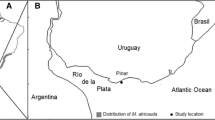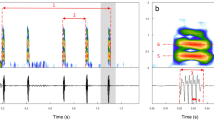Abstract
Sound production during reproductive behaviour, dyadic encounters and distress situations was investigated in the callichthyid catfish Corydoras paleatus. Sounds were broad-band, pulsed, acoustic signals produced during abduction of the pectoral spines. Only males emitted trains of sounds during courting and trains of sounds of shorter duration during dyadic encounters. Several males, which are usually smaller than females, courted one gravid female without obvious cooperation or competition between them. During mating, one previously vocalizing male clasped the female's barbels with one pectoral spine and inseminated the eggs. The number of successful spawnings, days until spawning, and number of eggs laid was not related to the number of males (one, two or three) combined with one female. Males did not behave aggressively towards each other during courting or in dyadic encounters. In distress situations, when fish were hand held, both sexes and juveniles produced single sounds. The dominant frequency was negatively correlated with body size and the sound duration was positively correlated with relative length of pectoral spines (standardized to body length). This acoustical behaviour in C. paleatus differs considerably from Hoplosternum thoracatum, a representative of the callichthyine subfamily, in which vocalization was observed during territorial behaviour in males and aggressive behaviour in both sexes. This is the first report of a major difference in vocalizing behaviour within one teleost family.
Similar content being viewed by others
References
Abu-Gideiri, Y.B. & D.H. Nasr. 1973. Sound production bySynodontis schall (Bloch-Schneider). Hydrobiologia 43: 415–428.
Bischof, C. 1996. Diversity of agonistic behaviour of croaking gourami (Trichopsis vittata, T. schalleri andT. pumila: Ana bantoidei) and the paradise fish (Macropodus opercularis: Anabantoidei). Aggr. Behav. 22: 447–455.
Brantley, R.K. & A.H. Bass. 1994. Alternative spawning tactics and acoustic signals in the plainfin midshipman fishPorichthys notatus Girard (Teleostei, Batrachoididae). Ethology 96: 213–232.
Burgess, W.E. 1989. An atlas of freshwater and marine catfishes. T.F.H. Publications, Neptune City. 784 pp.
Fine, M.L. 1978. Seasonal and geographical variation of the mating call of the oyster toadfish,Opsanu tau L. Oecologia 36: 45–57.
Fine, M.L., D. McElroy, J. Rafi, C.B. King, K.E. Loesser & S. Newton. 1996. Lateralization of pectoral stridulation sound production in the channel catfish. Physiol. Behav. 60: 753–757.
Fine, M.L., H.E. Winn & B.L. Olla. 1977. Communication in fishes. pp. 472–518.In: T.A. Sebeok (ed.) How Animals Communicate, Indiana University Press, Bloomington.
Gainer, H. 1967. Neuromuscular mechanisms of sound production and pectoral spine locking in the banjo catfish,Bunocephalus sp. Physiol. Zool. 40: 269–306.
Gerald, J.W. 1971. Sound discrimination by males of two cyprinid fishes. Texas J. Sci. 112: 48–54.
Gray, G.A. & H.E. Winn. 1961. Reproductive ecology and sound production of the toadfish,Opsanus tau. Ecology 42: 274–282.
Hawkins, A.D. & A.A. Myrberg. 1983. Hearing and sound communication underwater. pp. 347–405.In: B. Lewis (ed.) Bioacoustics, A Comparative Approach, Academic Press, London.
Hawkins, A.D. & K.J. Rasmussen. 1978. The calls of gadoid fish. J. Mar. Biol. Ass. U.K. 58: 891–911.
Ibara, R.M., L.T. Penny, A.W. Ebeling, G. Dykhuizen & G. Cailliet. 1983. The mating call of the plainfin midshipman fish,Porichthys notatus, pp. 205–212.In: D.L.G. Noakes et al. (ed.) Predators and Prey in Fisher, Dr W. Junk Publishers, The Hague.
Jenkins, R.E. & D.J. Jenkins. 1980. Reproductive behavior of the greater redhorse,Moxostoma valenciennesi, in the thousand islands region. Can. Field Nat. 94: 426–443.
Katano, O., K. Saitoh & A. Koizumi. 1988. Scatter — spawning of the catfish,Silurus asotus. Japan J. Ichthyol. 35: 203–211.
Kohda, M., M. Tanimura, M. Kikue-Nakamura & S. Yamagishi. 1995. Sperm drinking by female catfishes: a novel mode of insemination. Env. Biol. Fish. 42: 1–6.
Kratochvil, H. 1985. Beitrage zur Lautbiologie der Anabantoidei — Bau, Funktion und Entwicklung von lauterzeugenden Systemen. Zool. Jahrb. Physiol. 89: 203–255.
Ladich, F. 1990. Vocalization during agonistic behaviour inCottus gobio (Cottidae): an acoustic threat display. Ethology 84: 193–201.
Ladich, F. 1997a. Agonistic behaviour and significance of sounds in vocalizing fish. Mar. Fresh. Behav. Physiol. 29: 87–108.
Ladich, F. 1997b. Comparative analysis of swimbladder (drumming) and pectoral (stridulation) sounds in three families of catfishes. Bioacoustics 8: 85–208.
Ladich, F., W. Brittinger & H. Kratochvil. 1992. Significance of agonistic vocalization in the croaking gourami (Trichopsis vittatus, Teleostei). Ethology 90: 307–314.
Ladich, F. & H. Kratochvil. 1989. Sound production by the marmoreal goby,Protherorhinus marmoratus (Pallas) (Gobiidae, Teleostei). Zool. Jahrb. Physiol 93: 501–504.
Lugli, M., P. Torricelli, G. Pavan & P.J. Miller. 1996. Breeding sounds of malePadogobius nigricans with suggestions for further evolutionary study of vocal behaviour in gobioid fishes. J. Fish Biol. 49: 648–657.
Mayr, M. 1987. Verhaltensbeobachtungen anHoplosternum thoracatum, Cuvier & Valenciennes (1840), mit besonderer Berücksichtigung des Lautverhaltens. Ph.D. Thesis, University of Vienna, Vienna. 103 pp.
Myrberg, A.A. Jr. 1972. Ethology of the bicolor damselfish,Eupomacentrus partitus (Pisces: Pomacentridae): a comparative analysis of laboratory and field behaviour. Anim. Behav. Monogr. 5: 199–283.
Myrberg, A.A. Jr. 1981. Sound communication and interception in fishes. pp. 395–426.In: W.N. Tavolga, A.N. Popper & R.R. Fay (ed.) Hearing and Sound Communication in Fishes, Springer Verlag, Berlin.
Myrberg, A.A. Jr., M. Mohler & J.D. Catala. 1986. Sound production by males of a coral reef fish (Pomacentrus partitus): its significance to females. Anim. Behav. 34: 913–923.
Myrberg, A.A. Jr., E. Spanier & S.J. Ha 1978. Temporal patterning in acoustical communication. pp. 137–179.In: E.S. Reese & F.J. Lighter (ed.) Contrasts in Behaviour, John Wiley & Sons, New York.
Nelson, J.S. 1994. Fishes of the world. John Wiley & Sons, New York, 600 pp.
Noll, A.M. 1967. Cepstrum pitch detection. J. Acoust. Soc. Am. 41: 293–309.
Page, L.M. & C.E. Johnston. 1990. Spawning in the creek chubsucker.Erimyzon oblongus, with a review of spawning behavior in suckers (Castostomidae). Env. Biol. Fish. 27: 265–272.
Pfeiffer, W. & J.F. Eisenberg. 1965. Die Lauterzeugung der Dornwelse (Doradidae) und der Fiederbartwelse (Mochokidae). Z. Morph. Ökol. Tiere 54: 669–679.
Riglcy, L. & J. Muir. 1979. The role of sound production by the brown bullheadIctalurus nebulosus. Proc. Pennsylvania Acad. Sci. 53: 132–134.
Royce, W.F. 1951. Breeding habits of lake trout in New York. U.S. Fish. Bull. 59: 59–76.
Schachner, G. & F. Schaller. 1981. Schallerzeugung und Schallreaktion beim Antennenwels (Mandim)Rhamdia sebae sebae Val. Zool. Beitr. 27: 375–391.
Schneider, H. 1964. Bioakustische Untersuchungen an Anemonenfischen der GattungAmphiprion (Pisces). Z. Morph. Ökol. Tiere 53: 453–474.
Stout, J.F. 1963. The significance of sound production during the reproductive behaviour ofNotropis analostanus (family Cyprinidae). Anim. Behav. 11: 83–92.
Taborsky, M. 1994. Sneakers, satellites, and helpers: parasitic and cooperative behavior in fish reproduction. pp. 1–100.In: P.J.B. Slater, J.S. Rosenblatt, C.T. Snowdon & M. Milinsky (ed.) Advances in the Study of Behavior 23, Academic Press, San Diego.
Wallin, J.E. 1989. Bluehead chub (Nocomis leptocephalus) nests used by yellow shiners (Notropis lutipinnis). Copeia 1989: 1077–1080.
Winn, H.E. 1967. Vocal facilitation and the biological significance of toadfish sounds. pp. 283–304.In: W.N. Tavolga (ed.) Marine Bioacoustics, Pergamon Press, New York.
Winn, H.E. 1972. Acoustic discrimination by the toadfish with comments on signal system. pp. 361–385.In: H.E. Winn & B.L. Olla (ed.) Behaviour of Marine Animals, vol. 2, Vertebrates, Plenum Press, New York.
Author information
Authors and Affiliations
Rights and permissions
About this article
Cite this article
Pruzsinszky, I., Ladich, F. Sound production and reproductive behaviour of the armoured catfish Corydoras paleatus (Callichthyidae). Environmental Biology of Fishes 53, 183–191 (1998). https://doi.org/10.1023/A:1007413108550
Issue Date:
DOI: https://doi.org/10.1023/A:1007413108550




